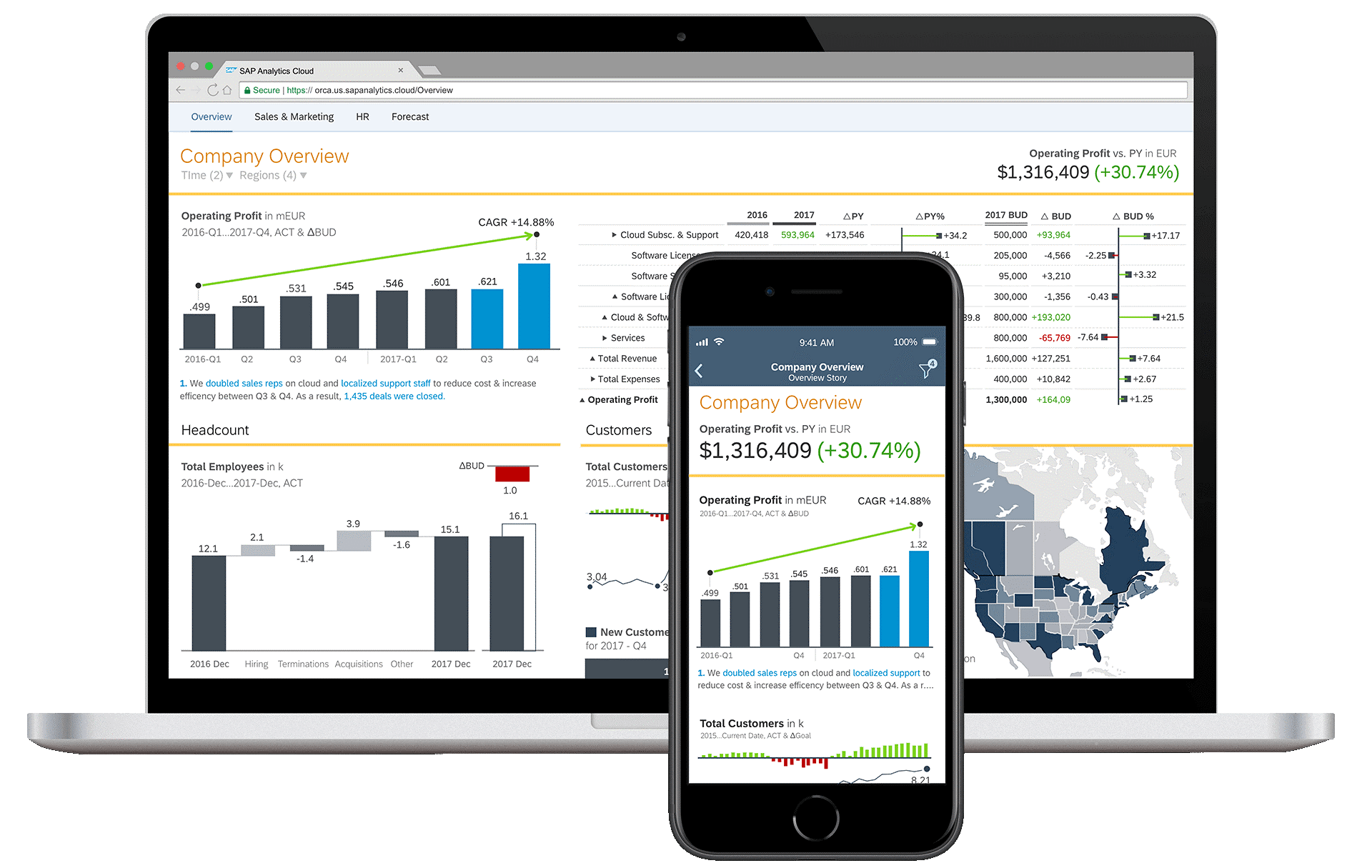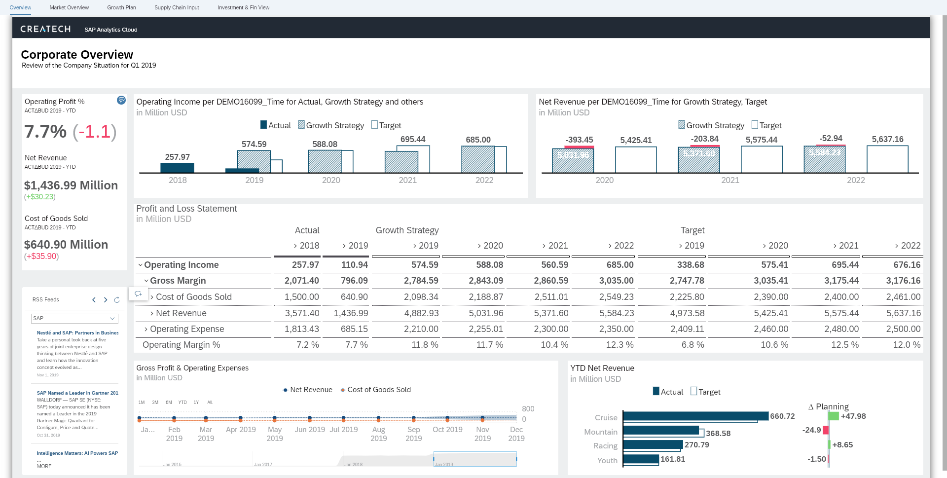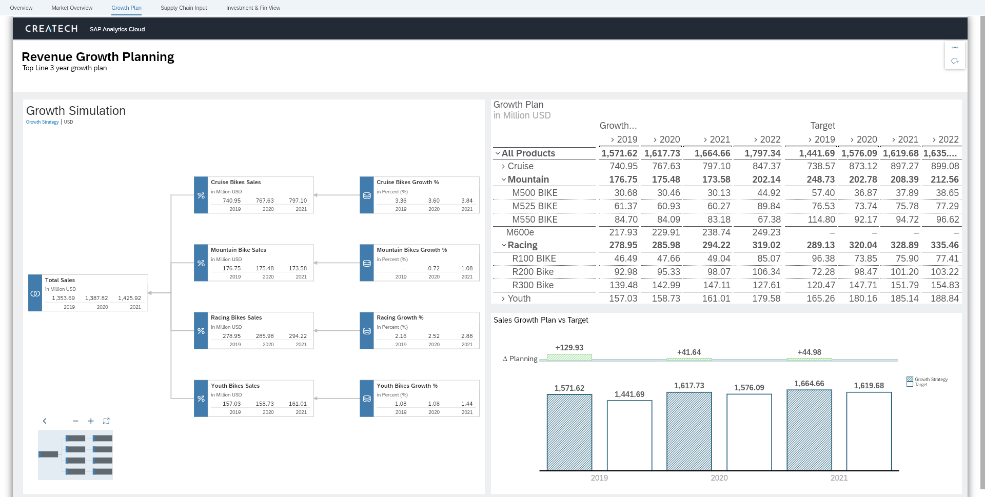SAP Analytics for cloud is cloud SaaS based Business Intelligence tool provided by SAP company. It was formerly known as Business Objects for cloud. It provides all the key functionalities of an Analytics tool to SAP business users.
Thistool is developed by SAP on HANA based BI platform and provides analytics compatibility from data coming from different database, CRM and ERP solutions. You can fetch data from Microsoft SQL, ERP solutions and Salesforce. Businessusers can compile the data, perform the data discovery, ad-hoc reporting and analysis to support predictive planning. SAP Analytics tool converts the rawdata from transactional system into meaningful insight for making better decisions.
Analytics feature in SAP tool depends on data algorithms, programming, and operations research to get data insight and to help the business in finding meaningful information from data coming from multiple data sources. This information isused by all enterprises to perform the business planning and forecasting.

Itsstrength? SAP Analytics Cloud combines the following functionalities in asingle tool:
🟩 Business Intelligence (BI)
🟩 Augmented Analytics
🟩 Modelling
🟩 Smart Transformation
🟩 Predictive Analysis
🟩 Planning
SAP Analytics tool uses machine learning technology to perform data cleaning, identify possible data errors and suggest filtering options. Modeling feature in Analytics cloud can be used to enhance your data and create hierarchies for deeper data insight.
SAP Analytics cloud provides below key features to end users:
🟩 Data Discovery
🟩 Machine Leaning capabilities
🟩 Integrated Financial and Business Planning
🟩 Predictive Analysis
🟩 Automated data cleansing
🟩 Data exploration and visualization
🟩 Role-Based customization for different users
🟩 Use of custom widgets
🟩 Applications Integration with on-premise sources
🟩 Mobile extension to connect with colleagues
SAP Analytics Cloud is one of most recommendedsoftware for Business Intelligence, these days. When you compare this tool withother similar tools, you can see vast range of features provided for end users- drag and drop reporting, real time analytics and BI insights, creating datavisualizations, dashboards and interactive stories, etc.
This includes key capabilities provided by HANA cloud platform andoffers capabilities like data connectivity and modeling, social collaboration,security and administration, web and mobile extensions and API’s basedintegration capabilities to integrate apps into existing BI solution.
This includes key capabilities of SAP Cloud platform related toanalytics and data processing. These features are focused based on analytics,data cleansing and visualization, use of custom widgets, Predictive analysiscapabilities, business and financial planning features and use of Machinelearning capabilities.

You can also stitch all the analytic applications into a boardroomand that can allow you to view in multiple screen, multiple metric access toyour enterprise metrics.
With this you can also drill to lowest level of your metrics.

SAP offers a complete solution when it comes to business intelligence. Accessible online in SaaS(software as aservice)mode, SAC is becoming increasingly important in the SAP ecosystem. Eventually, it is destined to become the BI reference tool for the SAP Cloud suite. Tofully understand its importance, we will answer the following questions:
🟩 What needs does SAC address?
🟩 What are the main features of SAC?
🟩 Who are SAC’s intended users?

In 2015, in a desire to develop a « Business Planning and Consolidation (BPC) Cloud », SAP released a product called « SAP Cloud for Planning » which offered planning functionalities. The German vendor improved it by adding a BI layer for data visualization and renamed it « SAP Business Objects Cloud ».
To further develop the product, SAP added an additional component of predictive analytics functionalities. This made it the first tool in the BI world to cover all three aspects of data visualization, planning, and predictive analytics.
In 2017, this enhanced product was renamed to SAP Analytics Cloud (SAC).
In 2019, new functionalities were added to create « analytical applications ». These applications complement the data visualization layer.
SAP Analytics Cloud is a new tool in the SAP portfolio to meet the needs of data visualization in the cloud. It is delivered as an all-in-one, SaaS-based product. It covers the needs of data visualization, budget planning, and predictive analytics.
This data can originate from a variety of sources: real-time data captured from your business activities, budget forecast data or even thousands of lines of data formatted as an MS Excel table.
The solution is intuitive and easy to use. It allows every user to produce reports of varying complexity with complete autonomy.
SAP Analytics Cloud allows data to be obtained through two methods:
🟩 What needs does SAC address?
🟩 What are the main features of SAC?
🟩 Who are SAC’s intended users?
Inthe case of an import, the data source can be a file, an SAP system, an OData service or an SQL database.
Inthe case of a direct read, refreshed real-time data is captured, only by connecting to an SAP system (HANA, BW, BPC or other).
This allows data preparation with additional features such as adding indicators, inserting formulas as well as modifying values of recovered characteristics.
This feature allows you to explore and highlight your data with graphs, tables orany other graphical components.

In order to be able to highlight relevant metrics or predict future results, SAPhas injected artificial intelligence innovations. A few application examples ofthese innovations include automated content creation via smart discovery,identification of influential characteristics, and detection of off-trend records,plus many others.
The planning section of SAC enables the combination of both your financial and your operational statements in the same tool for a complete and clear view of your current state.
Budget planning versions can be created and modified from existing financial statements. The provided machine learning and predictive forecasting tools can help anticipate your financials for future dates. Also available is the popular "What If" mode for performing simulations.

SAP Analytics Cloud is intended to be as accessible as possible: you don't need to come from the IT sector to gain control of the solution. In fact, you can easily become autonomous after a few short days of use.
These reports are designed to highlight key indicators that are representative of your business.
To fully exploit SAC, the ideal is to connect your ERP (whether it is cloud or not) as a data source. SAP has made it simple to connect to all the products in its suite. However, the solution is equally well suited to receiving data from flat files or any other data source.
Keep in mind that SAC allows mass data analysis. Therefore, by utilizing more data, this improves results, proposing more relevant highlighted key indicators.
The solution can be adapted to any business department that has sufficient data, whether it is a large company or an SME.
The reports can illustrate an overview of a company's activities providing real time savings for the executive. The reports can just as easily highlight key detailed indicators such as the number of customer sales orders or deliveries, for individuals who manage these activities in real time.
We are always close to you. Reach out to our office, contact our experts per service offering or interact with our thought leaders within Bisolera.
